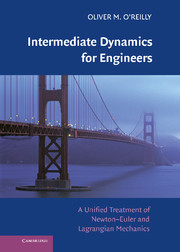Book contents
- Frontmatter
- Contents
- Preface
- PART ONE DYNAMICS OF A SINGLE PARTICLE
- PART TWO DYNAMICS OF A SYSTEM OF PARTICLES
- 4 The Equations of Motion for a System of Particles
- 5 Dynamics of Systems of Particles
- PART THREE DYNAMICS OF A SINGLE RIGID BODY
- PART FOUR SYSTEMS OF RIGID BODIES
- APPENDIX: BACKGROUND ON TENSORS
- Bibliography
- Index
5 - Dynamics of Systems of Particles
- Frontmatter
- Contents
- Preface
- PART ONE DYNAMICS OF A SINGLE PARTICLE
- PART TWO DYNAMICS OF A SYSTEM OF PARTICLES
- 4 The Equations of Motion for a System of Particles
- 5 Dynamics of Systems of Particles
- PART THREE DYNAMICS OF A SINGLE RIGID BODY
- PART FOUR SYSTEMS OF RIGID BODIES
- APPENDIX: BACKGROUND ON TENSORS
- Bibliography
- Index
Summary
Introduction
In this chapter, several examples of systems of particles are discussed. We pay particular attention to how the equations of motion for these systems are established by use of Lagrange's equations. The examples we discuss are classical and range from simple harmonic oscillators to dumbbell satellites and pendula. Our goals are to illuminate the developments of the previous chapter and to present representative examples.
Examples that are closely related to the ones we discuss can be found in many dynamics texts. Most of these texts use alternative formulations of Lagrange's equations of motion that do not readily accommodate nonconservative forces. Here, because we have established an equivalence between Lagrange's equations of motion and the balances of linear momenta, we are easily able to incorporate nonconservative forces such as dynamic Coulomb friction. This chapter closes with a brief discussion of some recent works on the dynamics of systems of particles.
Harmonic Oscillators
We first consider simple examples involving a system of two particles. The system shown in Figure 5.1 is the first of several related systems that we discuss in this section.
Referring to the figure, we see that a particle of mass m1 is connected by a spring of stiffness K1 and unstretched length L1 to a fixed support. It is also connected by a spring of stiffness K2 and unstretched length L2 to a particle of mass m2.
- Type
- Chapter
- Information
- Intermediate Dynamics for EngineersA Unified Treatment of Newton-Euler and Lagrangian Mechanics, pp. 134 - 160Publisher: Cambridge University PressPrint publication year: 2008



